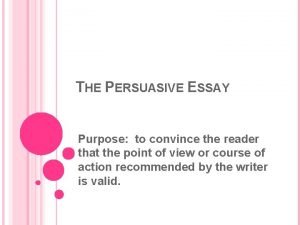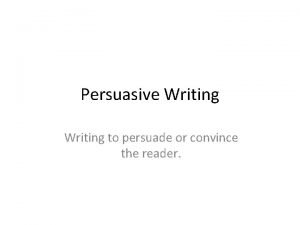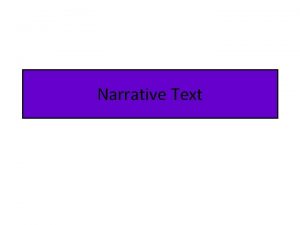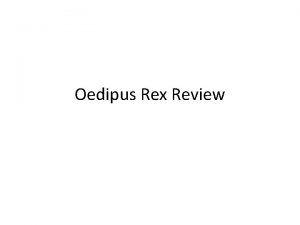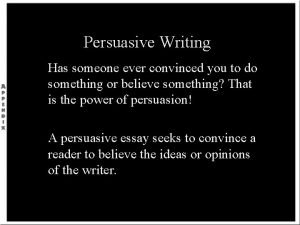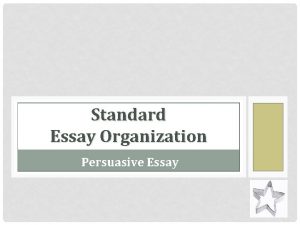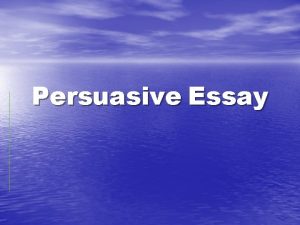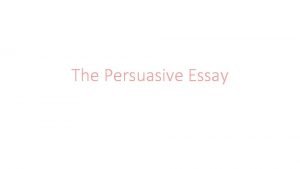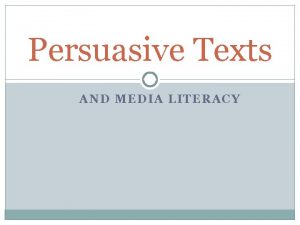THE PERSUASIVE ESSAY Purpose to convince the reader










- Slides: 10

THE PERSUASIVE ESSAY Purpose: to convince the reader that the point of view or course of action recommended by the writer is valid.

THE PERSUASIVE ESSAY To accomplish this, the writer must develop a limited topic which is well defined and debatable, that has more than one side. The persuasive essay must choose a side, make a case for it. Persuasive essays tend to use emotion/feeling as well as facts to persuade your audience. Assume that the audience is undecided and still on “your side”.

THE PERSUASIVE ESSAY It is important that the author understand other sides of the position so that the strongest information to counter the others can be presented In order to write an effective persuasive paper, you must anticipate and overcome objections that the opposition might raise. Dismissing these objections will completely weaken your own argument. You must refute alternative arguments, and prove to the undecided reader that the opinion it presents is the best one. For Example: German Shepherds are better than Jack Russell Terriers.

WHAT SHOULD MY THESIS STATEMENT LOOK LIKE? A persuasive thesis statement is a one-sentence description of your topic AND the argument that you plan to make. For example, if I was arguing about the use of the death penalty in the U. S. , my thesis statement would probably look like one of the following examples: § (Against) - The death penalty serves only to promote a culture of violence, not deter it from happening; therefore, the death penalty should be abolished in the United States. § (For) - The death penalty forces murderers to give their own lives as a just punishment for taking someone else's life; therefore, we should continue to use this form of punishment in the United States. o Notice that both thesis statements not only tell us WHAT the essay will be about, but also WHERE THE AUTHOR STANDS on that issue (his or her opinion) and briefly explain WHY.

THE PERSUASIVE ESSAY To write a persuasive paper, you’ll need to use evidence and good reasons to convince others to agree with your point of view on a particular subject. Select a good topic! If you don't care about your topic, how are you going to get anyone else to? You’ll also need to conduct effective research, obtaining facts and evidence to support your ideas. As you begin the research process, ask yourself: What type of information would I need to use in order to convince someone that I'm right? What facts, statistics, and evidence would an audience want to see? Are there any experts on this topic that I could quote in my essay? The answers to these questions should help you determine what key words you'll want to use, as you begin searching for sources.

THE PERSUASIVE ESSAY : IT’S TIME TO THINK ABOUT VISORS 1. The Pros and Cons of Wearing a Visor Pros: player safety Positive image of hockey as a sport as player safety is paramount Good example for young players Cons: Increase of dangerous behaviour on ice Interference with players ability to see Reduced ability for fans to identify and feel connected with players Negative image of hockey players as being over –protected

PLANNING AND DEVELOPING YOUR TEXT – IT’S TIME TO THINK ABOUT VISORS Form Persuasive Essay Purpose To persuade people that mandatory use of visors in the NHL is needed Public Audience NHL players and coaches Context To be published in the NHL newsletter mailed to all players/coaches Central Idea Inevitably people are beginning to debate the mandatory use of face protectors in the NHL.

THE PERSUASIVE ESSAY : PROGRESS The Pros and Cons of Technological Progress Pros: The Electric Light Medical Advancements, extending human life span. Faster transportation Email (Global conversations, faster, establishing voice) Cons: Global Warming Ozone depletion Nuclear waste disposal Anti-social behaviour Email (Haste, thoughtlessness and artificial urgency) Fast Food Mentality Impedes other forms of progress Cultural degeneracy

THE PERSUASIVE ESSAY: PROGRESS 2. Dryden’s thesis is open to debate. One may identify Dryden’s thesis in the third paragraph, second sentence: “And inevitably people are beginning to debate the mandatory use of face protectors in the NHL. ” However, it can also be argued that thesis occurs in the second-last paragraph: “Ten years from now, maybe 20, but sometimes, all hockey players will wear facial protection…. ” In either case the essay can be interpreted as an understated endorsement of visors. 3. Dryden inserts references to personal experience as a player in a number of places. For example, in paragraph two: “I have seen so many pucks and sticks…. , and in paragraph nine: “I know this from personal experience… By connecting to his personal experience and knowledge, Dryden suggests an element of expertise and involvement in the debate. His opinion matters and will likely be taken into consideration.

PLANNING AND DEVELOPING YOUR TEXT – PROGRESS Form Persuasive Essay Purpose To persuade people that technology does not always equal progress. Public Audience Youth - Adults (age 14+) Context TED talk (technology) Geek Monthly Magazine Winnipeg Free Press – Technology section Central Idea “For at least the past two hundred years, human society has operated under the assumption that all developments in science and technology constitute progress. ”
 The goal of this essay is to convince the reader – *
The goal of this essay is to convince the reader – * To convince the reader
To convince the reader Purpose of persuasive writing
Purpose of persuasive writing Define narrative text
Define narrative text Discuss and decide
Discuss and decide Priest in oedipus rex
Priest in oedipus rex Reporter destroys ice sculpture
Reporter destroys ice sculpture Persuasive words and phrases
Persuasive words and phrases We convince ourselves that life will be better
We convince ourselves that life will be better We convince ourselves that life will be better
We convince ourselves that life will be better We convince ourselves that life will be better
We convince ourselves that life will be better
